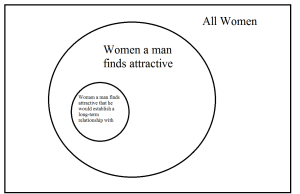This is going to be a rather uneven and disjointed post, as I intend to seek out the opinions of fellow bloggers and readers about some subjects which I’ve been thinking about lately. Mostly they concern ideas/theories which I have long held to be true, but now want second opinions about.
A Seller’s Market
Ever since I became acquainted with the Red Pill, I have believed that there were far more men who could be considered marriageable than women. Especially when it came to Christians; it has been my contention for a while that the number of chaste (even purposefully chaste) Christian men is greater by far than the number of chaste Christian women. I’ve always just assumed this, and never really gave it a whole lot of thought until recently. Given what I (think I) know about the current SMP/MMP, plus male/female attraction filters and the like, it would stand to reason that my belief is accurate.
If so, then it would appear to me that we are currently in a sellers market to a significant degree. A marriageable woman should be able to pick and choose amongst a variety of potential suitors. Furthermore, most such women should be able to easily satisfy their hypergamous instincts by “marrying up” to a man whose SMV is higher than their own. Given the dearth of women worthy to be wives, men would have to look down in SMV for mates, because the men above them have likely already taken their SMV equals for themselves. All of which means that a chaste Christian woman, to be specific, is sitting in the catbird’s seat when it comes to the MMP. [Of course, that ignores search and time costs inherent with any kind effort for her to find a husband.]
So the question is, am I off with my assessment? Or do my readers agree?
Male and Female Commitment
It is generally agreed upon that women are much more selective when it comes to attraction filters than men. I’ve written on the subject of female attraction before to explain how. Numbers often thrown around, although without anything more than anecdote as backing, state that men find roughly 50% of women attractive and women find only about 20% of men attractive. I don’t know if that is true or not. What I do know is that while men may find more women attractive than vice versa, that doesn’t mean that men are inclined to commit to those women. Just because a man wants to have sex with a woman doesn’t mean that he wants to commit to her. As part of this, I believe that men filter for commitment fare more stringently that women do for attraction. A simple graphic I created a while back illustrates this:
Speaking for myself, I will admit that when it comes to commitment I am rather wary. While my religious beliefs play a role in this, and no doubt the legal climate does as well, I suspect that men are hard-wired to be wary of commitment. Just as eggs are expensive for a woman, and so she must be careful whom she sleeps with, commitment is also expensive for men, and so they must be careful whom they invest in.
What I am curious about is if women also filter for men commitment from men in a similar way. Will women accept commitment from any man that they find attractive, or do they have a further set of requirements past the LAMPS categories. I assume that they do, and yet the argument from many quarters seems to be that “tingles uber alles”, or attraction is king. But clearly some women have certain desirable or comfort traits they look for in men, in addition to being attractive. I guess the question is whether those filters are as important for women as they are for men. My suspicion is that they aren’t; women are often willing to trade them away under the right circumstances.
What are my reader’s thoughts on the matter?
Tone Over Bulk
This topic isn’t nearly as deep, but do most men prefer tone over bulk when it comes to women and muscle? Stingray has re-posted an old post of hers called Hitting the Gym over at the new group blog Girls Being Girls, and it covers female exercise. While full of tips, she ends the post with this caveat:
One last thing, you can take lifting weights as far as your body will allow it. However, you should be aware of what your husband finds attractive. Some men do not like overt muscles on a woman. If this is the case, use lower weights with higher repetitions. You will gain tone without bulk or striations. Some men do find it very attractive and they admire the discipline behind what it takes to achieve. It’s really up to you (and your genetics) how far you wish to take it.
Count me in the category of men who prefer tone over bulk. Some overt muscles are alright in my book, but when it comes to the upper body I definitely prefer tone. For the legs I can make an exception, muscled legs don’t bother me, and might even be a plus in my book. The stomach/abs might be another area where some (but not a lot) of overt muscles are fine. But I happen to find too much muscle on women in the upper body area unfeminine, and think it detracts from the woman’s attractiveness. This is how I figured most men thought, so I’m curious to see if there is a general consensus on the matter.
Does this jive with my male readers? Do you prefer tone over bulk, or have certain areas where one might be more acceptable than the other?

